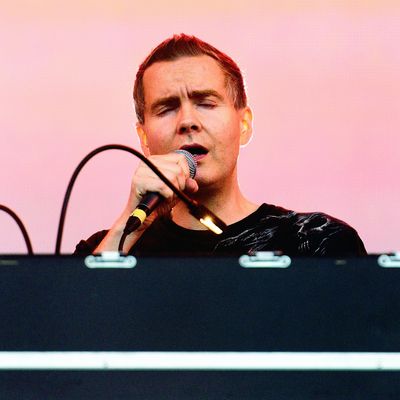
Jónsi has always been a generous collaborator. He’s lent music by his heady Icelandic art-rock band Sigur Rós to TV shows like Game of Thrones and Black Mirror; as a solo artist, the countertenor and bowed guitarist makes music with his ex-partner Alex Somers, has recorded songs for movies like the How to Train Your Dragon series, and worked with pop artists from Tiësto to Troye Sivan. So while teaming up with PC Music head and in-demand producer A.G. Cook for his new album Shiver isn’t totally unexpected, it’s still left-field for them — a merging of two clashing styles, Jónsi’s grand baroque-rock and Cook’s teched-out synth pop. The collaboration surprised Cook, a Sigur Rós fan, too, but ended up becoming one of his most fruitful: “It was kind of game-changing for my own outlooks and techniques,” he tells Vulture. Below, Cook describes how he got involved with Shiver (out October 2) and working with Jónsi.
I actually met Jónsi around six years ago — he was an early PC fan, unexpectedly. When I had my very first dodgy studio and almost nothing in it, I got this email through our management that was like, “Jónsi would love to visit. He’s on tour and this is his only stop.” The only thing he wanted to check out in London was the PC guys. Very strange. So I saw that and was like, “Yeah, great.”
I listened to Sigur Rós growing up, and even more recently actually. The more I ended up working with him, the more I realized how much it’s been an influence on my own harmonic language.
He turned up, and I think this would’ve been in 2014, maybe ’15, ages ago. He actually played me the Shiver demos when he was on tour doing the production and recording that years later I ended up properly working on, but he didn’t have the vocals back then. We just met, and he pitched up in the studio, with almost nothing in it, and just played all the instrumentals.
It was definitely inspired by Yeezus, and this kind of distortion mixed with field recordings and synth stuff. I was fairly shocked that he was playing me that kind of stuff anyway, these kind of beats. And then, we didn’t have the vocals yet, so he just stood up, and he was like, “Oh, do you mind if I do this? I can perform it now, just sing all the vocals.” And he just did it for 20 or 30 minutes, sort of angled to me. It was great, and I was super into it. Then we worked on some little bits of music that day.
We stayed in touch, and he was on this epic Sigur Rós tour [An Evening With Sigur Rós, from 2016-17]. We met up again when he came through and tried a few more files, but we were only semi in touch. And he was still asking about people working on the album, but it was very much his own project.
Way later, I was actually looking for places to work on my own stuff, and I emailed him. I was like, “Don’t you have this studio in Iceland that you and your boyfriend run? I’ve never been there, it’d be funny to just like … whenever.” And they got back to me, and they were like, “Oh, we just moved to L.A., haha. All the stuff’s in L.A. now.” I was like “Oh, okay, I go there quite a lot, let’s just meet up then.” And I went to their place and [was] working a bit just for fun and looking at their stuff, and still talking a bit about the album. The little sessions that we did felt very good.
Jónsi is a really interesting and pretty funny person. He’s got a really good sense of humor. There’s always this assumption that Sigur Rós might be super serious or whatever, but we’re pretty similar in some ways. He’s a bit of a prankster, and he’s kind of joyous, and he loves like classic-era Max Martin. You wouldn’t believe the songs they warm up to on their Sigur Rós tours. It’s total noughties bangers from all the biggest pop stars.
After touring and everything, he had basically finished a version of the album, mastered it, and just wasn’t happy with it. It felt not as confident as it could be. His vocal was really buried under all the stuff. So as I got to know him better, we just talked about it more frankly. I got to understand his own issues with his work so far, and he was probably more comfortable with me. So eventually he was just like, “Do you want to actually co-produce it?” And I was like, “Sure, but I need your dedicated time for a while, and I don’t think it should be in L.A. or London or Iceland. It has to be somewhere neutral.” I knew it was going to be a lot of work, and we’d have to really figure out how to make it gel.
We ended up picking Berlin, ’cause it has really good studios. We were there for a whole month. It was one place, and we just worked really hard; it was synth collectors as well as studio owners, it was just mad. We did a lot of versions of songs. I stripped them away, we played things, we wrote some new stuff, but it was just to figure out an ideal version of the sounds coming together. And I don’t think it was too big of a stretch in the end. We had this amazing track with Robyn that was very pop, and [it was] like, How do we make it noisy enough to fit with the other things?
He had super high standards about it all as well. We were kind of mentoring each other in terms of the standards we wanted it to be. And I learned a lot about even how he writes. There’s something amazing about a lot of his songs, where it doesn’t feel unfamiliar — it has this kind of, people sometimes call it epic, but it has these really catchy moments, but it doesn’t feel really simple. It’s accessible without being basic. Then I realized it’s ’cause he plays and sings everything together. He’ll never separate the melody from the chords. It’s not like [other frequent collaborator] Charli XCX, where she’ll write over a four-bar loop, then a verse and chorus, or something. He will just do melody as part of chords, either playing guitar and singing or playing keys and singing, or editing something and then figuring out that. So it’s all completely connected, which means he can do these chords that feel familiar, but then it’ll actually be like seven bars of this, and then a few beats of this. All the proportions are quite complex and artful, but the building blocks aren’t crazy. It was getting so complicated, with all the synthesis and other things, I had to map out these tracks and sort of memorize them temporarily. It became a really cool process.
The first track on the album, “Exhale,” we did completely together from scratch, and were comfortable with how the sounds worked out. And that started to complete it. I was working on that before Charli’s self-titled album, even though it’s coming out after, and you can kind of hear [it]. Some of the mad synthesis that happens on the Charli album is a result of some experiments that I was doing with the Jónsi album, and how that fed back into that. It pushed my sound.





